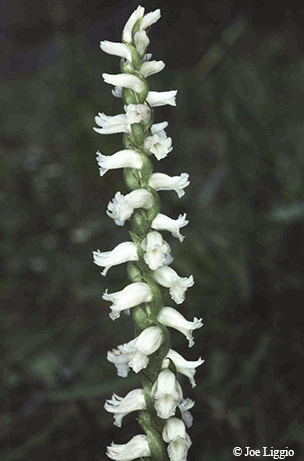
Flora Fact: Spiraling Blooms
Ladies’ tresses orchids rise like delicate corkscrews.
By Jason Singhurst
The delicate orchids were waving among the bunch grasses as the morning frost hung dewdrops on their heads, looking like white candles sparkling between the majestic post oak and blackjack oak trees. It was the first time I had encountered ladies’ tresses orchids, during a botanical survey in the fall of 1992 at Fort Boggy State Park. Elray Nixon, emeritus plant ecologist at Stephen F. Austin State University, pointed out two different species in the post oak savanna.
Ladies’ tresses orchids (Spiranthes species) appear across Central, East and North Texas landscapes and are among the most common orchids in the state. Thirteen of 42 species of ladies’ tresses occur in Texas.
Spiranthes comes from the Greek words speira (“spiral”) and anthos (“flower”). The twisted, spiraling appearance of orchids in this genus is also reflected in common species names like ladies’ tresses and corkscrew orchids.
The spiraling flower arrangement is the result of uneven cell growth, which results in a twisting of the flower stems.
Ladies’ tresses orchids are members of the orchid family, perennial herbs growing from fleshy root systems that are sometimes thick and appear tuberous. The flowers are white, cream or light green and grow along the upper part of the slender, erect stem, which varies from one to two feet tall. The flowers grow in two to four spiraling rows, forming a dense spike about six inches long. The individual flowers curve downward slightly with a nodding appearance. The labellum (or lip) is about a half-inch long, with a flaring, crimped margin that acts as a landing platform for insects to pollinate the flower. Ladies’ tresses orchids are one of the few orchids that have fragrance.

Ladies’ tresses orchids in Texas occur in prairies, oak savannas, pine savannas, bogs, stream bottoms, swamps and shallow soils in rocky glades and roadsides. Ladies’ tresses orchids respond to prescribed burns, and as a result, naturally induced fires most likely play a role in their reproduction.
Many bee species visit the flowers of ladies’ tresses orchids for nectar. White-tailed deer and cottontail rabbits occasionally browse the foliage and flowers, but due to their inconspicuous nature, ladies’ tresses orchids are often overlooked.
The most widespread ladies’ tresses orchid in Texas is the nodding ladies’ tresses (Spiranthes cernua), blooming from late September through December. In Texas, they occur in the granite Llano Uplift in places such as Inks Lake State Park and the edges of vernal pools at Enchanted Rock State Natural Area. They are found in blackland and coastal prairie remnants, post oak savannas and chalk limestone glades in eastern Texas. These flowers are arranged on the stalk as intertwined double spirals, making the individual spirals not readily discernible.
Southern ladies’ tresses (Spiranthes lacera var. gracilis) can be encountered September through November in eastern Texas. They occur throughout the blackland prairies and coastal prairies and most commonly appear in post oak savannas, including places such as Bastrop and Lake Somerville state parks.
Other fall blooming ladies’ tresses orchids include the giant spiral orchid, Great Plains ladies’ tresses, fragrant ladies’ tresses, oval ladies’ tresses and the endemic (restricted to Texas) Navasota ladies’ tresses.
» Like this story? If you enjoy reading articles like this, subscribe to Texas Parks & Wildlife magazine.
Related stories
Flora Fact: Here Comes the Sun

